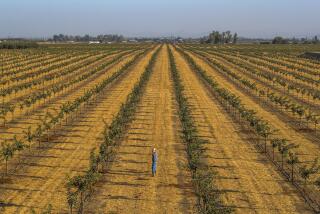More Fallout From Rain
- Share via
The economic effects of February’s heavy rains continue to spread beyond the state’s almond orchards. First, the weather grounded bees just when they should have been up and around pollinating, causing the buds to drop without bearing and cutting the anticipated crop nearly in half.
Now, the short crop has prompted the California Almond Growers Exchange (CAGE) to close two Southern California plants, trim 91 year-round jobs--35 in Fullerton--and scale back plans for hiring seasonal hands to process the harvest this fall.
The goal: to lop $20 million off overhead.
CAGE--the state’s largest almond processor, which markets under the Blue Diamond label--will permanently close its processing plant in Fullerton, which at the season’s height employed up to 400 workers. The plant’s work force numbered 100 in June and will be trimmed to a mere handful by the end of the summer as closure is completed. The plant’s manufacturing equipment will be stored for future use at the main plant at the group’s headquarters in Sacramento.
The exchange hopes to sublease the leased Fullerton property, which was occupied formerly by Berrenda Mesa Farms. It has no plans to reoccupy the site, however, said Ray Linzy, director of plant operations.
At Lost Hills in Kern County, the exchange will close for this year an almond-receiving station, where Southland almonds were shelled, sorted and stored under a handful of full-time employees and about 50 seasonal workers. Lost Hills has fed the Fullerton plant, but in the future will send almonds to Sacramento, Linzy said.
The 91 year-round jobs were eliminated through voluntary early retirements, abolishing unfilled positions and resorting to the cooperative’s first white-collar layoffs in 25 years. More than half the layoffs and retirements will thin the ranks in marketing, finance, data processing, administration and plant supervision at Sacramento. All other employees’ salaries have been frozen until better times, and the exchange expects to take on 1,000 fewer seasonal workers this fall than the 2,500 hired to handle last year’s crop.
California’s almond crop, which accounts for all the nation’s commercially grown almonds, is now estimated at 250 million pounds of shelled nuts, 46% lighter than 1985’s. Of this, CAGE normally processes and markets about 60% for its member-growers, who number 5,400 of the state’s total of 7,000 producers. The exchange reports that its membership fell 2.3% after this spring’s sign-up period--after several years of closed enrollment because of swollen inventories of unsold nuts produced by a parade of record and near-record harvests, with resulting low prices. CAGE exploited the surplus to develop new products and new markets--most recently in the Soviet Union--and this program has succeeded in reducing last year’s “carry-over” to what in a normal crop year would be ideal size.
Hopes that the 1986 crop and those new markets would finally bring a financial reward to those growers who have managed to hang on through five years of low prices were dashed by February’s ill-timed rains. Consequently, CAGE will find itself in the ironic position this year of having to scramble to come up with enough almonds to meet the newly expanded demand for all forms of almonds and such recent spinoffs as almond butter, almond-laced breakfast cereals and almond-based cosmetics.
While prices will surely rise due to short supplies, the reduced yields will likely leave most growers with disappointing total returns.


